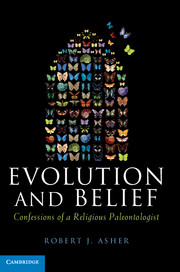Book contents
- Frontmatter
- Contents
- Acknowledgments
- Prologue
- One Science and Religion
- Two Evolution as a Science
- Three Characters and Common Descent
- Four The Fossil Record
- Five The Roots of Mammals
- Six A Brief History of Elephants
- Seven Whales are no Fluke
- Eight Creationism
- Nine DNA And The Tree pf Life
- Ten DNA and Information “Creation”
- Eleven Biology and Probability
- Twelve Evolution, Education, and Conclusions
- Notes
- Bibliography
- Index
Five - The Roots of Mammals
Published online by Cambridge University Press: 05 March 2012
- Frontmatter
- Contents
- Acknowledgments
- Prologue
- One Science and Religion
- Two Evolution as a Science
- Three Characters and Common Descent
- Four The Fossil Record
- Five The Roots of Mammals
- Six A Brief History of Elephants
- Seven Whales are no Fluke
- Eight Creationism
- Nine DNA And The Tree pf Life
- Ten DNA and Information “Creation”
- Eleven Biology and Probability
- Twelve Evolution, Education, and Conclusions
- Notes
- Bibliography
- Index
Summary
Let us return to the predictions made by the theory of evolution by natural selection outlined in Chapter 2. One prediction we made arising from the occurrence of natural selection over time is that certain animals should mix adaptations and morphologies seen in others, comprising what are popularly known as “missing links,” or species that stretch the definition of exactly what constitutes a given category of organisms. In fact, as described for the coqui, platypus, bandicoot, and tarsier in Chapter 3, you don’t need fossils to observe suites of transitional features that link major animal groups. But of course we have them—lots of them—and to the unbiased observer they document the previous existence on Earth of an extraordinary array of life, now extinct. These fossils are in many cases representative of the common ancestors shared by major groups recognized today. You’ve heard of at least some of the most impressive fossils that enjoy the status of “missing link.” Starting with the letter “A,” you might recognize the names Acanthostega, Archaeopteryx, or Australopithecus. The list goes on (see Table 8.1)—Adapis, Aetiocetus, Apateon, Apternodus, Ardipithecus, Asioryctes—but most of these aren’t quite as famous.
Archaeopteryx is probably the most famous fossil in the world. It’s a bird-like animal from the late Jurassic (about 150 million years ago) of southern Germany. Modern birds show feathers, powered flight, beaks, and lack tails and teeth. Archaeopteryx, in contrast, blurs the definition of “bird” because it combines features we associate with very different groups in one animal. It has the flight-adapted forelimbs and feathers of a bird, but the teeth, hip bones, and long tail of a lizard. For well over 100 years, up until a rash of discoveries in the 1990s–2000s, Archaeopteryx was one of only a few fossils that challenged our understanding of what a “bird” really is, anatomically speaking.
- Type
- Chapter
- Information
- Evolution and BeliefConfessions of a Religious Paleontologist, pp. 89 - 111Publisher: Cambridge University PressPrint publication year: 2012

